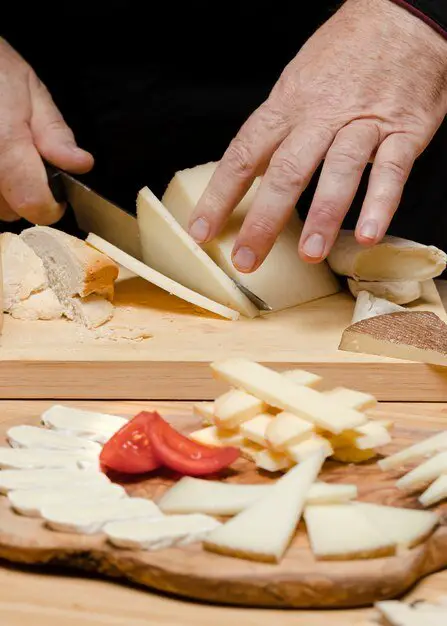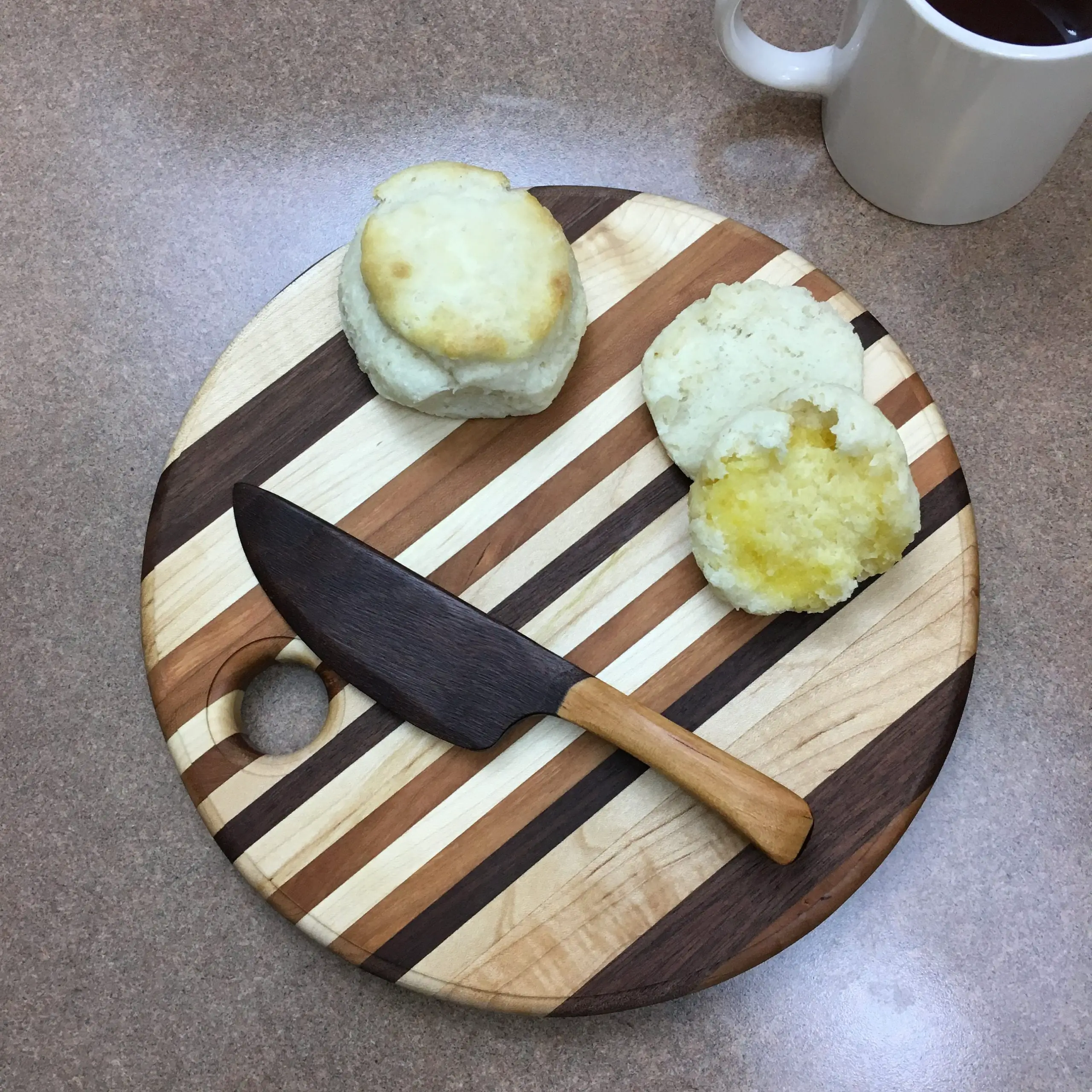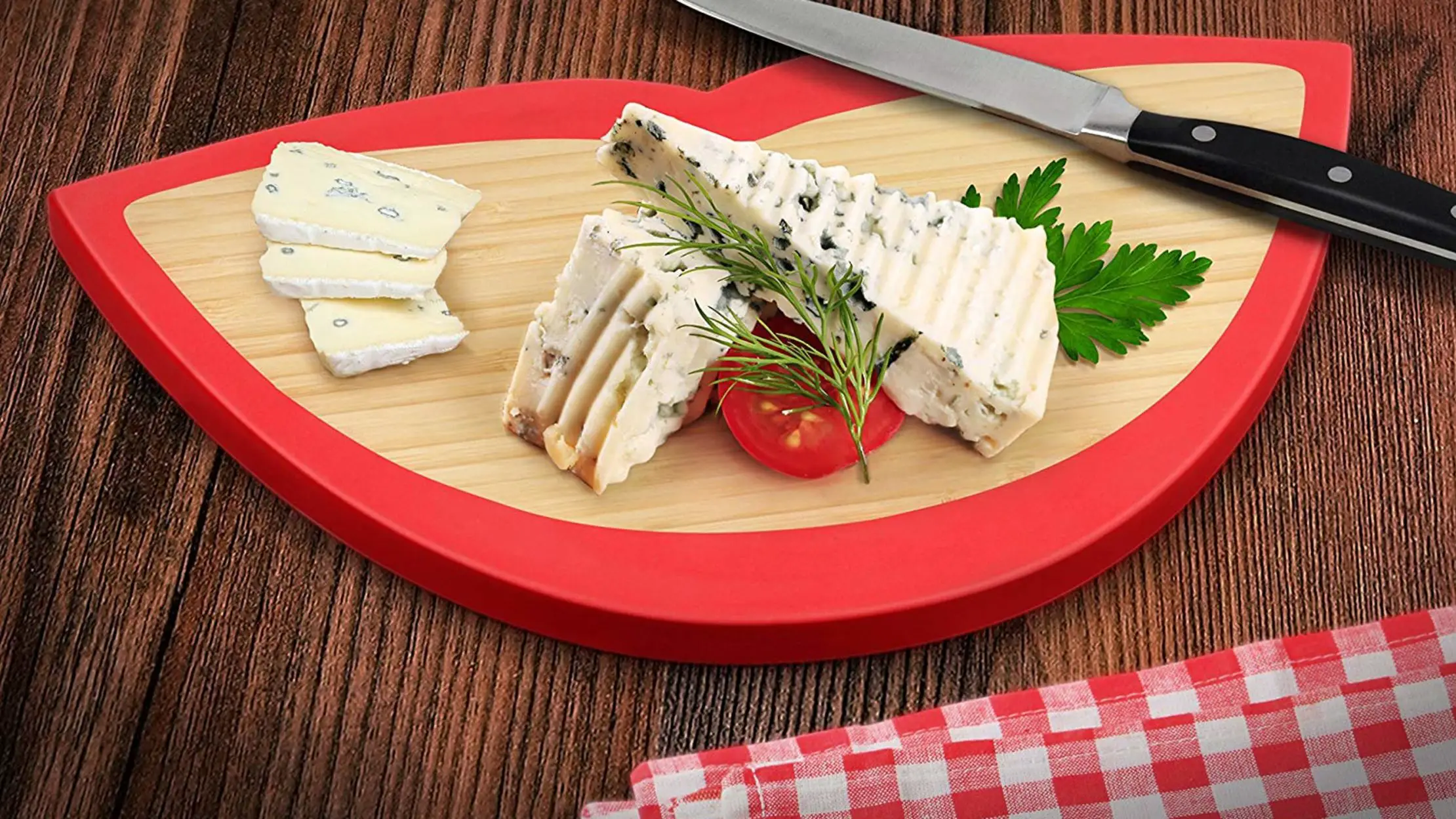Thou Shalt Not Wrap Cheese In Plastic Wrap
Yes, I know. This is a tough one. And to be totally frank, this is probably the cheese crime I’m most guilty of committing myself. Does the Serious Eats office fridge contain a hunk of excellent Parmesan wrapped in plastic? Yes. Are we proud of that fact? No. No we are not.
“Cheese is a living, breathing thing, and without proper oxygen, it will suffocate,” explains Stephanie Stiavetti, author of Melt: The Art of Macaroni and Cheese. “Your best bet is to wrap it in a finely porous material, such as cheese paper, parchment paper, or breathable plastic wrap made especially for cheese.” If that sounds pesky, what you can do is rewrap your cheese in the paper your cheesemonger used and then wrap that package up loosely in plasticit’ll stay breathable while helping the cheese retain its moisture. You can find more cheese storage tips here.
One Or Two Soft Cheeses Tops And Make Sure They’re Mild
It might take a little bit of convincing to gain people’s trust when it comes to soft cheeses but the good news is, once a person tries them, it’s usually love at first bite. There’s a strong misconception surrounding brie and other soft cheeses many people think they’re too stinky, that the rinds are inedible , and that most of them taste like feet. When it comes to brie, the most approachable and beloved cheese of all is a triple creme. This type of brie is like slicing into a wedge of slightly sweet and mild butter, hence the ‘creme’ in the name.
If blue cheese is your soft cheese of choice, make sure to go with something mild. Cheese such as a Bayley Hazen Blue or soft gorgonzola are great choices… Steer clear of Roquefort or Stilton. Another wonderful option for soft cheese is goat cheese, specifically fresh chévre. This type of goat cheese is mild in flavor with more of a tang and salty finish than any other flavor note and goes perfectly with fresh herbs, a drizzle of honey, nuts, and dried or fresh fruit. Many times, chévre goat cheese logs can be found already rolled in any of these toppings.
What Does Gouda Cheese Taste Like
The younger Gouda cheeses will have a more mild, soft, and almost sweet taste and texture. Theyre best on sandwiches or crackers. The older Gouda cheeses become harder, stronger, and darker, taking on a buttery and nutty flavor. The deep flavor of the older Gouda makes it great for cooking , with crusty bread, or with wine.
Also Check: Hazen Meats
Can You Use A Cutting Board For A Cheese Board
I have a large slate board that I nabbed from Crate and Barrel that I love. I think the black background really makes everything look beautifulit also allows you to write on it in chalk .
Dont have a specialty cheese board? Aint no thang. Use a big cutting board , a serving platter, or even a cookie sheet worksit looks all rustic and cute-like. Any large flat surface will work.
Think About Real Estate

Now that you have your cheeses and other board accompaniments, you want to think about which items take up the most room. If you have a cheese board, grab that. If not, a wooden cutting board will do just fine. Put the biggest things down on the board first. Those are usually the cheeses and perhaps charcuterie if youre using it, and the crackers or bread. At this point, Toth advises thinking about how people are going to eat the cheese. Pre-portioning cheese into chunks or wedges is a good way to prevent what Toth describes as acts of cheese abuse, like one guest hollowing out the center of a wheel of brie, or another hacking a wedge into an unattractive or inexplicable shape. If you care about those aesthetics, the portions are the way to go.
You May Like: How To Say Acai In Spanish
How To Make An Easy Cheese Board
Cheese boards are life. If you invite me to a party and a cheese board is there we will be instant BFFs. They make such a beautiful presentation and are the perfect way to welcome your guests. The great thing about a cheese board is that there is something there for everyone. Sweet, salty, crunchy there are so many delicious flavors and textures involved. A cheese board doesnt have to be complicating and I am here to show you how to create an easy to make cheese board.
Step 1: Pick a Cheese Board
I recently added this cheese board to my shop. I am obsessed with it! I love the round board and the utensils and tools needed for serving that slide out from underneath. It is easy to clean and heavy duty. It is perfect for serving guests. I like to serve it on a marble slab with additional jams, mustards, and olives.
Step 2: Add Cheese
How To Label A Cheese Board
A cheese board isn’t finished until the cheeses are labeled so that everyone knows what theyre eating. You can label a cheese board with reusable markers, disposable signs or flags, or create a map or menu to share this information with your guests. Our favorite way to label a cheese board is to use a writable cheese board. Black cheese boards are best for this because their color allows chalk to show up really well. When youre done, simply wash the board and the labels disappear.
You May Like: Lemon Tree Dwelling
Prepare And Place Cheeses
Once youve selected your cheese, its time to choose a board. You can get one large board or multiple small onesbe creative! I usually go with wood or marble.
As I get ready to prep everything for the board, I like to keep a few things in mind. First, to help keep things picture-perfect, I keep softer cheeses cold and let harder and crumblier cheeses warm up a bit. This will help keep the softer cheese from smearing or oozing while cutting, and it makes it easier to slice hard or crumbly cheeses.
I always work off board at a workstation to prepare everything. This workstation is usually my everyday cutting board and a sturdy kitchen knife. I like to stage the cheese, so I cut the white and mild cheeses first and end with the colorful and bold-flavored cheeses last to prevent color and flavor transfer.
I also like to think about how I will cut, slice or crumble the cheese and have a plan in mind before I start to prep and place. That means ensuring each cheese has its own unique shapethat will help you and your guests remember which is which. This is especially true if two cheeses look like each other when cut.
Soft and semi-soft cheeses slice and cube easily, while firm and hard cheeses are great in sticks, triangles, or even crumbled.
How To Cut Cheese Blocks
There are two things to keep in mind when learning how to slice cheese blocks: maximizing surface area and creating bite-sized slices. Its more enjoyable to eat a slice of cheese rather than a cube because slices maximize the surface area when placed in the mouth. Additionally, each slice should be a manageable size so you or your guests arent struggling to eat too-large pieces of cheese.
To cut cheese off of a block, first cut the block horizontally to create two smaller hunks of cheese, then cut each piece into 1/8″ slices.
Don’t Miss: Do Sealed Cheese Sticks Need To Be Refrigerated
Start With The Hard Cheeses
These are the cheeses that most people go for first because, in a way, they’re the most familiar. This is where you’re likely to find cheeses such as cheddar, which is by far the most popular cheese for both devoted fans as well as those who aren’t completely sold on cheese culture. In terms of appearance, hard cheeses are a little more approachable and their flavor is anticipated to be less than that of blue cheese or brie. They’re also easier to grab on the go with a pair of tongs or a toothpick, so special attention should be paid to these – and hard cheeses should also outweigh the other cheeses in terms of amount and the space taken up on a platter.
Of course, cheddar is the safest option. If cheddar is the cheese of choice, however, then make it a good cheddar – never something that comes pre-sliced or in a semi-soft block. A good nutty, aged cheddar is something that will really wow the crowd and looks pretty on a plate. For a bit of good, earthy funk, consider a Lecistershire cheese – it’s red and crumbly with a strong yet approachable flavor. For a hardcore sharp cheddar, consider an Irish cheese with a little bit of oomph to it.
Whats The Difference Between A Cheese Board And A Charcuterie Board
The terms cheese board and charcuterie board are often used interchangeably, but they mean different things. Cured meats are the focus of a charcuterie board . On the other hand, cheese is the star of a cheese board, with accompanimentswhich can include charcuterieselected to best highlight the cheeses. A good serving board can be used interchangeably to serve cheese or charcuterie.
Read Also: Soapstone Serving Tray
Thou Shalt Not Let The Cheese Languish
This one’s just common sense: if you’re left with bits and pieces after a party or picnic, make sure to use up those delicious nubs! Maybe with an easy, elegant mixed cheese quiche? Or really anything you like just check out our tips for cooking with cheese before you get started, or hop over to our massive, cheese-packed recipe collection.
More Serious Eats Recipes
How To Style A Charcuterie Board

Also Check: Babybel Expiration
Portions Are Better Than Blocks
When setting out cheese, hosts sometimes offer bigger wheels or wedges of cheese for guests to hack into. But unless the cheese is too soft to chop up neatly, Toth says its better to serve it pre-cut and portioned out.
Properly cut cheese is more visually appealing, more comfortable to eat, and safe from random acts of cheese abuse, Toth says.
Weve all seen that chunk of brie with the buttery center gouged out, and the sad, empty rind left behind on the serving board, she says. Pre-portioning is a great way to avoid that sort of thing.
And while presenting guests with a big hunk of cheese requires less work, it slows down serving, and most people prefer grab-and-go access to their food, says Pat Polowsky, food scientist and cheese expert.
Once the cheese is cut up, the clock is ticking, and you need to consume it pretty soon, versus if you just have a block and people are slicing off from it, he says.
As pre-cut cheese is left out, light and oxygen causes it to discolor, dry out, and lose flavor, Polowsky says.
Themed Options And Variations
How to make a seasonal cheese board: I love to allow the seasons to influence the simple or fancy cheese platter offerings. Here are just a few cheese board ideas for seasonal additions.
- Spring/Summer: fresh berries, peaches , in-season cherry tomatoes, radishes, fresh apricots, cantaloupe, and even fresh basil .
- Fall: apple and pear slices, roasted squash/pumpkin slices, grapes, apple butter, etc. You could also use fall-inspired crackers like these fallen leaves crackers.
- Winter: pomegranate seeds, clementines, cranberry sauce, figs, fig jam, dried cranberries, roasted Brussel sprouts.
Cheeseboard charcuterie: Ive kept this at the bottom of the list, as I dont often add any meat to my cheese boards . However, if you want to add some meat, you could use Salami, prosciutto, cured beef/ham, nduja, mortadella, soppressata, etc. You could also add a spreadable like pâté .
Vegetarian cheese board: I dont tend to add any meat to cheese boards anyhow. However, what you do have to look out for are cheeses that contain rennet. Otherwise, these cheese boards are naturally vegetarian.
Vegan cheeseboard: all of the guidelines and tips mentioned in this post apply for a vegan cheese board, too just using dairy-free cheese instead .
You can also prepare themed cheese platters based on the holidays or on the region /
Also Check: Why Does Babybel Cheese Come In Wax
Don’t Miss: Another Name For Brick Cheese
What To Put On A Cheese Board
The general idea is to provide a good combination of flavors, textures, and even colors to provide both contrast and balance. This makes them a little more than your average Christmas cheese and cracker platter.
However, the exact ingredients of your cheese board will depend on the time of year, holidays, or theme . The resulting fruit and cheese platter is perfect for serving at any special occasion, party, or large gathering. You can also prepare a cheese board gift!
Dont Miss: Philly Cheese Steak Pizza Dominos Sauce
What Cheese Knife Do You Use
The knife is used for cutting semi-hard or semi-soft cheese. It can also be used for spreading the cheese on crackers and bread. The fork is used for picking up the cheese you have already cut.
I think this is why I am so obsessed with my new cheese board. It comes with all of the tools you need and are stored right inside of your cheese board. They are sturdy and cut the cheese like butter.
Final tips and Garnish
Make sure your cheese board looks full and has plenty of variety for your guests. There is nothing more beautiful than a full and vibrant cheeseboard waiting for your guests. I always garnish mine with a few sprigs of rosemary at the end. This is all it takes to create an awesome cheese board!
You May Like: How Long Is Babybel Cheese Good For
How To Cut Cheese Like A Pro
No gathering is complete without the right cheeseboard to spice up the party. But, how do you cut cheese so it looks like this?
Were here to tell you how. And, its really quite easy!
First, go to your local grocer or cheese shop with an idea of how much cheese youll need. A good rule of thumb is to account for 3 to 4 ounces of cheese per guest if it is not being served as the main course. Each wedge of cheese will vary in size, but most are 4 to 8 ounces. Choose a variety of types and flavors. Ok, now lets get started making that cheeseboard
Anchoring The Cheese Board
Anchor the board with a wedge of cheeses. Cut a cheese in half, at an angle, stack it. Anchoring the board means to set the focal point of the cheese board. Often the board has the focal point in the center but I also like to have the anchor at the top. Depending on how the board will be displayed will depend on where it will be anchored. Enjoyed from all sides, center of the table? Anchor the board in the center. If the board will be served from one side, such as on a single sided buffet table, go with the anchor at the top or off to the side. Once again, these are just suggestions to get you started.
Read Also: Can Babybel Cheese Go Bad
Selecting The Serving Platter
There are plenty of options on what to use as your cheese board serving tray. Think outside of the ordinary. As long as the item is food-grade safe, it is useable! Ideas include:
- Large wooden cutting board
- Wooden serving trays
- Lazy Susan
And if youre already thinking about the holidays then a beautiful serving platter is a great gift! Check out my Gift Guide for the Home Cooks or Holiday Gift Guide for Foodies Under $15 for more ideas. Or any of these fun tools!
Also Check: How To Use Ricotta Cheese
Can You Eat The Rind Of The Cheese

When you are ready to serve, it is time to determine whether to eat the rind or to leave it on the plate. The rind is an outer shell that forms naturally during the maturing process. They are edible more often than not and help enrich the taste of the entire cheese.
On cheeses such as Parmesan, the natural rind is often too hard to eat, but are great when making stock or sauces. With softer rinds, found on Double Crème and Brie, you are good to go if you feel like eating the entire cheese. These rinds are often referred to as bloomy rinds and form when the refiner sprays the raw cheese with a yeast-like fungus, eventually creating a supple skin around the exterior. When the refiner instead swabs the cheese in brine or alcohol, you end up with a washed rind. This helps bacteria develop the unique color and smell found on the exterior and the smooth consistency in the center. Cheeses with washed rinds come in different varieties some are creamy, while others are hard like cheddar.
Ultimately, it is up to you to decide if you want to eat the rind. If you are hesitant, try a small section of the cheese with the rind still on it to see if you like it.
Castello in social media
Recommended Reading: Flat Lay Backdrop Boards